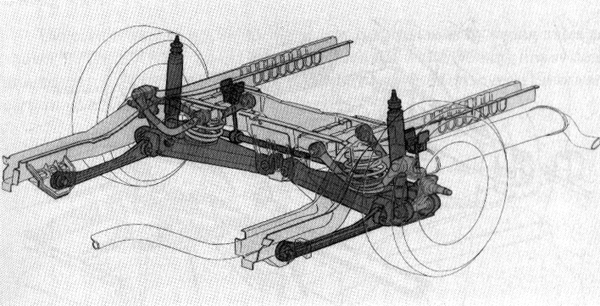
| MadSci Network: Engineering |
Konrad,
Mulitlink suspensions don't necessarily keep the wheel perfectly vertical to the ground all of the time, but they certainly do a better job than swing axles (a la Corvair and the old Beetle) and they have other advantageous characteristics over solid axles. But, the best way to explain this to you is to show you. Here is a drawing of the multi-link rear suspension from a Ford Taurus:

What you see is that the wheel is mounted to the suspension via the spindle. The spindle then has two control arms at the top and the bottom which connect back to the frame of the vehicle. This suspension has an additional link from the lower control arm to the vehicle. For now, we'll ignore this link because the other 3 parts are what are important for your question, keeping the tire vertical. By the way, in the automotive world, we refer to this type of orientation as "camber." A perfectly vertical tire is said to have no camber. If it tilts outward from the vehicle at the top, it has positive camber, and if it tilts inward it has negative camber. I'll probably be using this term from now on.
Here is a simple front-view drawing of a multi-link front suspension (this particular type of suspension is called short/long arm or SLA).

From this view, we can really start to understand how the linkages work to control tire camber. You may want to try building your own suspension model using some strips of cardboard, brads, and this picture. That way you can have your own working model to study. This picture also shows the tie rod which is used for steering, but you don't have to put that in your model. It may sound stupid, but I actually had to do this as a homework assignment in college for my class on machines when we were studying linkages, and it really helps you understand what is going on. Just use a piece of cardboard to represent the upper arm, lower arm, spindle, and the rest of the car. Put the brads at each of the circles and start playing. If you wanted to get real fancy, you could actually try to make the spindle piece look like it has a tire attached to it.
Anyway, what I'm hoping this will show you is exactly what you asked: how a multilink suspension keeps the tire vertical. The system shown in the picture won't keep the tire perfectly vertical as it moves up and down. This is typically how most suspensions are made. The tire will loose camber during jounce (when the tire moves upward). This effect will be negligible during small changes (bumps), but more pronounced during large changes (for example, when the vehicle "rolls" or leans during cornering). If you think about it, this makes sense. The effect of body roll would normally cause the top of the tire to lean outward during the turn. But, if the tire leans inward as it moves upward, this will help to counteract this effect. If you wanted to prevent any camber change as the tire moves up and down, the upper and lower control arms must be the same length and parallel.
There's a lot more to vehicle suspension systems than I can explain in one Mad Scientist answer page. If you really want to learn more, go find yourself a book on vehicle dynamics and suspensions. My recommendation is a book called "Fundamentals of Vehicle Dynamics" by Thomas Gillespie. The book is published by SAE (Society of Automotive Engineers) and is probably the most common text book for introductory vehicle dynamics classes. This book covers ride, handling, cornering, suspensions, steering, tires, braking, acceleration, the works. It is availble through SAE and can be found here. You may also be able to find it at a college bookstore or maybe even in the library. If you can't find this particular book, I'm sure there are plenty of other good books that are availble at the library that could help you to learn more.
I hope that helped you. Please let me know if you have any other questions.
Your Mad Scientist,
Mike Scannell
Try the links in the MadSci Library for more information on Engineering.